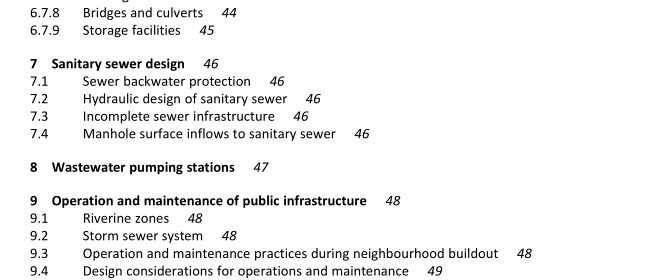CSA W204:19 pdf download – Flood resilient design of new residential communities.
2 Reference publications This Standard refers to the following publications, and where such reference is made, it shall be to the edition listed below. CSA Group PLUS 4013:19 Technical guide: Development, interpretation and use of rainfall intensity-duration-frequency (IDF) information: Guideline for Canadian water resources practitioners S6:19 Canadian Highway Bridge Design Code CAN/CSA-W202-18 Erosion and sediment control inspection and monitoring Z800-18 Guideline on basement flood protection and risk reduction National Research Council Canada National Plumbing Code of Canada, 2015 Other publications Ball, J., Babister, M., Nathan, R., Weeks, W., Weinmann, E., Retallick, M., and Testoni, I., eds. 2019. Australian Rainfall and Runoff: A Guide to Flood Estimation. Commonwealth of Australia.
Canadian Dam Association. 2013. Dam Safety Guidelines. Toronto. City of Calgary. 2011. Stormwater Management and Design Manual. Calgary. City of Edmonton. 2015. Design and Construction Standards – Volume 3 – Drainage. Edmonton. Construction Industry Research and Information Association (CIRIA). 2014. Managing urban flooding from heavy rainfall – encouraging the uptake of designing for exceedance. CIRIA Research Project RP991, London. Federal Highway Administration (FHWA). 2013. Hydraulic Engineering Circular no. 22 — Urban Drainage Design Manual. Publication No. FHWA-NHI-10-009, 3rd edition, Washington, D.C. Ministère du développement durable, de l’environnement et de la lutte au changement climatique (MDDELCC). 2011. Guide de gestion des eaux pluviales. MDDELCC, Québec. Ministry of Transportation of Ontario (MTO). 1997. Drainage Management Manual. MTO, Toronto. Moudrak, N., and Feltmate, B. 2017. Preventing Disaster Before It Strikes: Developing a Canadian Standard for New Flood-Resilient Residential Communities. Intact Centre on Climate Adaptation, University of Waterloo. Public Safety Canada. 2018. Federal Flood Mapping Guidelines Series. Available at: https://www. publicsafety.gc.ca/cnt/mrgnc-mngmnt/dsstr-prvntn-mtgtn/ndmp/fldpln-mppng-en.aspx Roads and Transportation Association of Canada (RTAC). 1982. Drainage Manual – Volumes 1 and 2. RTAC [now Transportation Association of Canada (TAC)], Toronto. Urban Drainage and Flood Control District (UDFCD). 2016. USDCM Volume 1. Denver, CO.
3 Definitions and abbreviations 3.1 Definitions The following definitions shall apply in this Standard: Alluvial fan — area where drainage from mountainous terrain emerges out onto a flatter plain creating a ‘fan’ where flows move to occupy many positions of drainage and sedimentation over time. Annual exceedance probability (AEP) — the annual likelihood of a flood occurring, expressed as a fraction of 1.0. Note: The 0.01 AEP flood is equivalent to both the 1% annual probability flood, and the 100-year return period flood, although the term AEP is less misleading than the concept of return periods to many people. Backwater valve — a device that mitigates storm or sanitary sewage in an overloaded main sewer line from backing up into a basement. Note: The valve automatically closes if the flow from storm or sanitary sewage attempts to back up into a basement from the main sewer.
Benching — haunching that sits between the manhole walls and the channel pipes. It is there to streamline the flow path thus reducing hydraulic losses which could lead to undesired surcharge of the pipe system. Clearance — the distance between the soffit of a structure and the high-water level in a channel. Combined sewer — a sewer that carries both wastewater and stormwater. Critical infrastructure — processes, systems, facilities, technologies, networks, assets, and services essential to the health, safety, security, or economic well-being of Canadians and the effective functioning of government. Note: Disruptions of critical infrastructure could result in catastrophic loss of life, adverse economic effects, and significant harm to public confidence. Debris flow hazard — the potential for water-laden masses of soil and fragmented rock to flow down slopes and pose a risk to public or private property, human safety, and/or the environment. Design flood — a specific flood magnitude that is used for a design purpose, including delineating Flood Hazard Areas. Note: In Canada, the 0.01 AEP flood is used as the minimum design flood for delineating Flood Hazard Areas, and many jurisdictions use higher magnitude floods (e.g., 0.005 AEP) or design storms. The design flood is usually expressed as flow in meters per second, and hydraulic analysis is then used to calculate the corresponding elevation and extent (Public Safety Canada, 2018). Design storm — a rainfall intensity/duration value defining a regulatory storm for regulatory purposes, or for system modelling purposing (either major or minor system). Note: This value can be applied at various scales from community to watershed. Design storm values can be based on either probability or historic parameters. Detention — a temporary storage with a controlled release rate, where the outflow volume of stormwater equals the inflow volume of stormwater. Downspout — a drainpipe that conveys stormwater from the roof of a structure to a sewer for disposal or onto the ground.CSA W204:19 pdf download.
